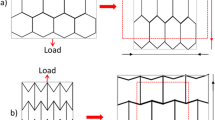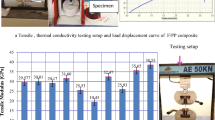Abstract
The use of natural fibre reinforced composites such as flax fibre / polypropylene is in a constant expansion particularly in automotive and marine industries due to their good mechanical properties, low density and thus, lightness, low environmental impact, low cost, recyclability, renewable properties of flax fibres and a minimum energy intake during their process. One of the major challenges of thermoplastic composites for the automotive industry is to manufacture finished parts in a single processing step within a minimum amount of time. For this purpose, a stamping airflow device was specifically developed. It is designed to produce woven comingled composite parts from comingled woven fabrics such as flax/polypropylene in only 200 s. Firstly, preliminary tests and the optimization of processing parameters were performed. Then, a quasi-static mechanical characterization of the formed parts was realized. By using criteria based on mechanical properties, the optimal process parameters such as the level of pressure, temperature, holding time and cooling rate so that to obtain the lowest voids rate were determined. Finally, a comparison of the mechanical properties of parts obtained from using the new manufacturing process and a conventional thermo-compression process is presented to demonstrate the interest and the level of performance achieved by this original and fast manufacturing device.
















Similar content being viewed by others
References
Shah DU (2013) Developing plant fibre composites for structural applications by optimising composite parameters: a critical review. J Mater Sci 48:6083–6107
Baley C (2002) Analysis of the flax fibres tensile behaviour and analysis of the tensile stiffness increase. Comp Part A : Appl Sci and Manuf 33(7):939–948
Yan L, Chouw N, Jayaraman K (2014) Flax fibre and its composites – A review. Comp Part B 56:296–317
Shah D, Schubel P, Clifford M (2013) Can flax replace E-glass in structural composites? A small wind turbine blade case study. Comp Part B 52:172–181
Zimniewska M et al (2012) Natural Fiber textile structures suitable for composite materials. J of Natur Fib 9:229–239
Duflou J, Yelin D, Acker K, Dewulf W (2014) Comparative impact assessment for flax fibre versus conventional glass fibre reinforced composites: are bio-based reinforcement materials the way to go? CIRP Ann 63(1):45–48
Sharma S, Sutcliffe M, Chang S (2003) Characterisation of material properties for draping of dry woven composite material. Comp Part A 34(12):1167–1175
Ouagne P, Soulat D, Allaoui S, Hivet G (2010) Mechanical properties and forming possibilities of a new generation of flax woven fabrics. Proceeding of the 10th international conference on textile Composite (Texcomp), p. 345, Lille
Rudd C, Long A, Kendall K, Mangin C (1997) Liquid Moulding technologies. England, Cambridge
Shekar I et al (2011) Hybrid fabrics for structural composites. J of Industr Text 41(1):70–103
Fitoussi J, Bocquet M, Meraghni F (2013) Effect of the matrix behavior on the damage of ethylene–propylene glass fiber reinforced composite subjected to high strain rate tension. Comp Part B 45(1):1181–1191
Picher-Martel G, Levy A et PH (2016) Compression moulding of carbon/PEEK randomly-oriented strands composites: A 2D finite element model to predict the squeeze flow behaviour. Comp Part A 81:69–77
RocTool (2016) http://www.roctool.com/company/news-and-releases/roctool-launches-new-performance-cooling-units. Accessed 20 Jan 2016
Charlet K, Jernot J, Breard J, Gomina M (2010) Scattering of morphological and mechanical properties of flax fibres. Industr Crops and Prod 32(3):220–224
Charlet K et al (2009) Influence of an Agatha flax fibre location in a stem on its mechanical, chemical and morphological properties. Comp Sci and Technol 69:1399–1403
Le Duigou A et al (2014) A multi-scale study of the interface between natural fibres and a biopolymer. Comp Part A 65:161–168
Madsen B, Thygesen A, Lilholt H (2007) Plant fibre composites – porosity and volumetric interaction. Comp Sci and Technol 67:1584–1600
Yan L, Yiu-Wing M, Lin Y (2000) Sisal fibre and its composites: a review of recent developments. Comp Sci and Technol 60:2037–2055
Peterlin A (1975) Plastic deformation of polymers with fibrous structures. Colloid and Polym Sci 253:809–823
Samuels RJ (1985) Polymer structure: the key to process property control. Polym Eng & Sci 25:864–874
Ouagne P, Bizet L, Baley C, Breard J (2010) Analysis of the film stacking processing parameters for PLLA/flax fibre biocomposites. J of Comp Mat 44:1201–1215
Bourmaud A, Le Duigou A, Gourier C (2016 Jun) Baley C (2016). Influence of processing temperature on mechanical performance of unidirectional polyamide 11–flax fibre composites. Ind Crop Prod 84:151–165
Gassan J, Bledzki AK (2001) Thermal degradation of flax and jute fibers. J Appl Polym Sci 82:1417–1422
Destaing F (2012) Contribution à l’étude du comportement mécanique de matériaux composites biosourcés lin/PA11 élaborés par thermocompression. Dissertation, University of Caen Normandie
Berges M et al (2016) Influence of moisture uptake on the static, cyclic and dynamic behaviour of unidirectional flax fibre-reinforced epoxy laminates. Comp Part A 88:165–177
Liang S, Gning P-B, Guillaumat L (2015) Quasi-static behaviour and damage assessment of flax/epoxy composites. Mater and Design 67:344–353
Yan L, Qian L, Hao M (2015) The voids formation mechanisms and their effects on the mechanical properties of flax fiber reinforced epoxy composites. Comp Part A 72:40–48
Oksman K (2001) High quality flax fibre composites manufactured by the resin transfer moulding process. J of Reinf Plastics and Comp 20:621–627
Georgiopoulos P, Christopoulos A, Koutsoumpis K, Kontou E (2016) The effect of surface treatment on the performance of flax/biodegradable composites. Comp Part B 106:88–98
Martin N, Davies P, Baley C (2016) Evaluation of the potential of three non-woven flax fiber reinforcements: Spunlaced, needlepunched and paper process mats. Industr Crops and Prod 83:194–205
Couture A, Lebrun G, Laperrière L (2016) Mechanical properties of polylactic acid (PLA) composites reinforced with unidirectional flax and flax-paper layers. Comp Struct 154:286–295
Madsen B, Lilholt H (2003) Physical and mechanical properties of unidirectional plant fibre composites—an evaluation of the influence of porosity. Comp Sci and Technol 63:1265–1272
Angelov I et al (2007) Pultrusion of a flax/polypropylene yarn. Comp Part A 38:1431–1438
Oksman K (2000) Mechanical properties of natural fibre mat reinforced thermoplastic. Appl Compos Mater 7:403–414
Nassiopoulos E, Njuguna J (2015) Thermo-mechanical performance of poly(lactic acid)/flax fibre-reinforced biocomposites. Mater & Design 66:473–485
Kong K, Park P, Lee J (2014) Study on structural design and analysis of flax natural fiber composite tank manufactured by vacuum assisted resin transfer molding. Mater Letters 130:21–25
Gu H, Liyan L (2008) Research on properties of thermoplastic composites reinforced by flax fabrics. Mater & Design 29:1075–1079
Liu L, Zhang B-M, Wang D-F, Wu Z-J (2006) Effects of cure cycles on void content and mechanical properties of composite laminates. Comp Struct 73:303–309
Campbell F, Mallow A, Browning C (1995) Porosity in carbon fiber composites an overview of causes. J of Advan Mater 26:18–33
White S, Kim Y (1996) Staged curing of composite materials. Comp Part A 27:219–227
Gu Y, Li M, Zhang Z, Sun Z (2010) Void formation model and measuring method of void formation condition during hot pressing process. Polym Compos 31:1562–1571
Grunenfelder L, Nutt S (2010) Void formation in composite prepregs – effect of dissolved moisture. Comp Sci and Technol 70:2304–2309
Koushyar H, Alavi-Soltani S, Minaie B, Violette M (2012) Effects of variation in autoclave pressure, temperature, and vacuum-application time on porosity and mechanical properties of a carbon fiber/epoxy composite. J Compos Mater 46:1985–2004
Herrmann A, Nicke J, Riedel U (1998) Construction materials based upon biologically renewable resources—from components to finished parts. Polym Degrad and Stab 59:251–261
Gourier C, Le Duigou A, Bourmaud A, Baley C (2014) Mechanical analysis of elementary flax fibre tensile properties after different thermal cycles. Comp Part A 64:159–166
Mohanty AK, Khan MA, Sahoo S, Hinrichsen G (2000) Effect of chemical modification on the performance of biodegradable jute yarn-biopol® composites. J. of. Mater Sci 35:2589–2595
Van de Velde K, Kiekens P (2003) Effect of material and process parameters on the mechanical properties of unidirectional and multidirectional flax/polypropylene composites. Comp Struc 62:443–448
Alcock B et al (2006) The mechanical properties of unidirectional all-polypropylene composites. Comp Part A 37:716–726
Acknowledgements
We warmly thank Angers Metropole Regional Foundation for supporting this researching work and DEPESTELE group for supplying the comingled flax-PP fabrics used in this work.
Author information
Authors and Affiliations
Corresponding author
Ethics declarations
We confirm that this work is original and has not been published elsewhere nor is currently under consideration for publication elsewhere.
Conflict of interest
The authors declare that they have no conflict of interest.
Additional information
Publisher’s Note
Springer Nature remains neutral with regard to jurisdictional claims in published maps and institutional affiliations.
Rights and permissions
About this article
Cite this article
Derbali, I., Terekhina, S., Guillaumat, L. et al. Rapid manufacturing of woven comingled flax/polypropylene composite structures. Int J Mater Form 12, 927–942 (2019). https://doi.org/10.1007/s12289-018-01464-1
Received:
Accepted:
Published:
Issue Date:
DOI: https://doi.org/10.1007/s12289-018-01464-1




